
No one was injured, and a black bear was chased away with rubber bullets and beanbag rounds after it spent three hours at Anderson County High School, mostly eating acorns, on Tuesday, Oct. 6, 2016. (Photo by John Huotari/Oak Ridge Today)
Note: This story was last updated at 8:40 a.m.
CLINTON—No one was injured, and a black bear was chased away with rubber bullets and beanbag rounds after it spent three hours at Anderson County High School, mostly eating acorns, on Tuesday.
The bear was first seen at about 3:55 p.m. Tuesday on the east side of a parking lot on the east side of the high school campus.
ACHS Assistant Principal Ben Downs, Principal Andrea Russell, and a school resource officer were involved in a student issue in the parking lot, when Downs looked over his left shoulder and saw the bear.
“There it was coming out of the woods,” Downs said.
Classes had just dismissed for the day, and sports teams had just started after-school practices. They were soon canceled.
The bear, which was docile and believed to be a young adult, didn’t seem to be bothered by the school officials and officers that kept watch on it along a tree line east of the high school parking lot and south of the Mavericks football field. It spent much of its time digging and eating acorns under a white oak tree in a small wooded area next to the parking lot.
“No students were ever in any danger,” said Jason Lankford, Tennessee Wildlife Resources Agency wildlife officer. “The bear was never aggressive to students. No one was ever in any danger today.”
While a few bears that have come through the area in previous years have seemed skittish around humans, this one didn’t seem to mind the people nearby, even briefly sitting and laying in plain sight of the small group of officials and officers watching it.
“It seemed all too comfortable with all this,” Lankford said.
He said the bear looked like it had been fed or habituated to humans. Feeding bears can lead to negative consequences, Lankford said, as he stressed this message: Don’t feed bears. Also, if you’re feeding dogs and cats outdoors, make sure you leave only enough food for them and not enough for raccoons, skunks, and bears. Lankford said he hoped Tuesday’s experience made the bear less comfortable around humans.
After about two hours, the TWRA, which generally encourages the animals to move along, brought a trap and tranquilizing equipment.
But they didn’t need to use either. Instead, Anderson County Sheriff Paul White, Sheriff’s Department deputies, and TWRA officers armed with rifles, shotguns, and a TWRA pickup truck flushed the bear, estimated to weigh 175-200 pounds, into the small stand of woods and scared it over a chain-link fence on the east side of the high school campus. They fired a half-dozen or so rubber and beanbag rounds in the general direction of the bear over a 15-minute period starting at 6:30 p.m.
Before it fled, the bear had essentially trapped itself in a corner at ACHS, making it past a chain link fence, possibly crawling over it or under it, and ending up at the corner of two chain link fences with a highway to the south and the high school to the west.
“We had to persuade him to move on,” TWRA Wildlife Officer Jason Lankford said. “When at all possible, we let the bear move on.”
TWRA and school officials had both been concerned about student and staff safety, and the Anderson County Sheriff’s Department set up a perimeter around the bear in the parking lot on the east end of campus. They kept students away.
Allen Russell, ACHS assistant softball coach, said the team was on the track, just starting workouts, when principals announced there was a bear on campus and directed everyone to get inside.
After it climbed the fence to leave ACHS a few hours later, the animal was last seen headed north at about 7 p.m. ACSD deputies briefly stopped traffic on Charles G. Seivers Boulevard in case it headed south across that divided four-lane highway.
It’s not uncommon to see bears in East Tennessee, especially in the spring and summer. They can come from Big South Fork National Park to the north and Great Smoky Mountains National Park to the south.
But it’s more unusual to see them in the fall. And nine out of 10 bears keep moving, Lankford said, but this one needed some encouragement.
Lankford said he wasn’t sure if the bear was a male or female. He said it had just “come on the (TWRA’s) radar” about one-half mile up the road. Normally, TWRA receives more calls about a bear and can actually plot its travel based on the calls. Lankford said he expected to receive calls Tuesday night as the bear headed north.
If you see a bear, Lankford said, make sure to give it a wide berth.
More information will be added as it becomes available.
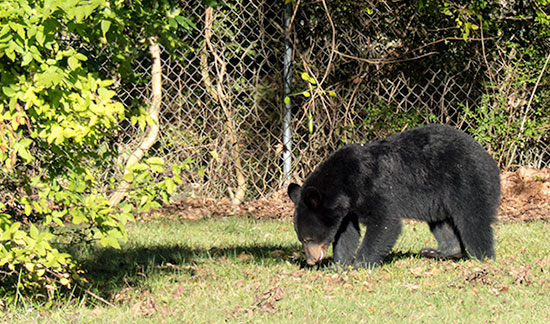
A black bear that was at Anderson County High School for about three hours on Tuesday, Oct. 6, 2015, spent much of its time digging and eating acorns under a white oak tree on the east side of campus. (Photo by John Huotari/Oak Ridge Today)
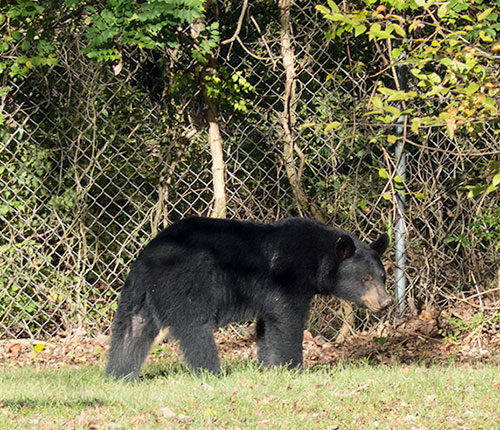
After local and state officers flushed it at about 7 p.m., this black bear climbed a chain link fence on the east side of Anderson County High School and was last seen headed north on Tuesday, Oct. 6, 2015. (Photo by John Huotari/Oak Ridge Today)
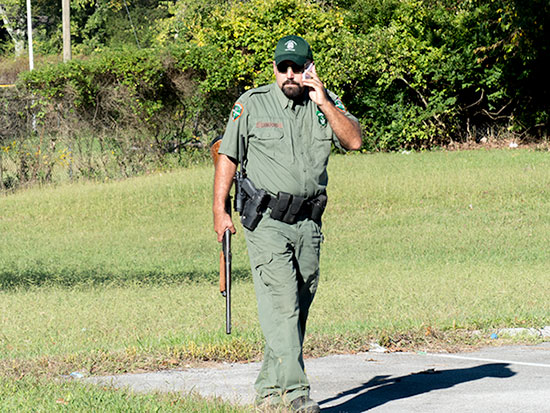
TWRA Wildlife Officer Jason Lankford sets up a perimeter on the northeast corner of Anderson County High School after a black bear was reported there at about 3:55 p.m. Tuesday, Oct. 6, 2015. (Photo by John Huotari/Oak Ridge Today)
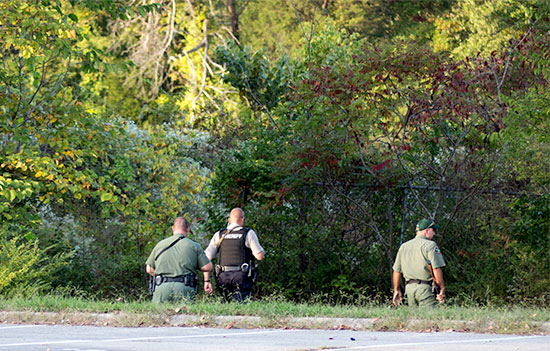
Armed with shotguns, rifles, and rubber bullets, Anderson County Sheriff’s Department deputies and Tennessee Wildlife Resources Agency officers chase a black bear from Anderson County High School on Tuesday, Oct. 6, 2015. (Photo by John Huotari/Oak Ridge Today)
Copyright 2015 Oak Ridge Today. All rights reserved. This material may not be published, broadcast, rewritten, or redistributed.
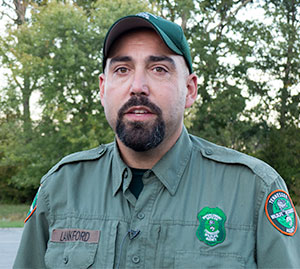
Leave a Reply